VII. Assignment of Proceeding
Commissioner Michael R. Peevey is the Assigned Commissioner and Carol A. Brown is the Assigned Administrative Law Judge (ALJ) in this proceeding.
1. The purpose of this decision is to adopt a policy, on a limited and interim basis, to support new generation and long-term contracts for California which can ensure investment in construction in a timely fashion so new generation can begin to come on-line in 2009.
2. This decision must work in concert to coordinate and incorporate Commission and legislative efforts from other proceedings, and in particular R.05-12-013 that is addressing competitive market mechanisms in Phase II of that proceeding.
3. The State's energy policy uniformly points to the need for the State to invest in new generation in both northern and southern California in order to assure continued reliable service at reasonable cost.
4. We previously found in D.04-12-048 that PG&E had a need for 2,200 MW and SCE had a need for 1,500 MW.
5. We intend to examine in Phase II of this proceeding whether there is any additional system need for new capacity in the service territories of SCE, PG&E and SDG&E.
6. We find that long-term contracts are necessary to solicit investment in new generation in California.
7. We previously implemented RAR for each LSE requiring it to be responsible for acquiring its own reserves to meet its own RA obligation.
8. In D.04-12-048, we approved the IOUs' LTPPs and associated rate-making treatment, and authorized the IOUs to enter into short, medium, and long-term contracts.
9. In D.04-12-048, we allowed the IOUs to recover any stranded costs from all customers for a period of either the life of the contract, or 10 years, whichever is less.
10. Despite our removal of barriers to long-term contracting by approving the IOUs' LTPP and cost recovery, establishing RAR year-ahead obligations and allowing for stranded cost recovery, neither PG&E nor SCE have entered into any long-term contracts or built new generation themselves.
11. PG&E and SCE have indicated that they are reluctant to take procurement steps that would leave the cost-recovery for new generation with their respective bundled customers alone, and they have requested cost-recovery for above-market costs from all customers.
12. Since our decision in D.04-12-048 in December 2004 there has not been sufficient investment in new generation in California from non-utility sources.
13. We find that we need an additional transitional policy to encourage investment in new generation resources now while we continue to pursue competition and customer choice by establishing a functioning market based institution.
14. We find given the urgent need for new capacity and the lengthy lead-times required both for new construction and to develop and implement new market institutions, it is necessary and prudent for us to take proactive steps now to support investment in new generation.
15. The only complete solution for this transitional policy presented to the Commission was the Joint Parties' proposal which proposed making the IOUs the procurement entities for bundled and unbundled customers alike.
16. Many parties critiqued the JP, but only proffered the alternative solution of "staying the course" which translates into continuing with ongoing market reforms and hoping that new capacity will get built.
17. Other parties constructively analyzed the JP, including the Indicated Parties, and offered modifications that limited the procurement role of the IOUs.
18. We find that it is reasonable to adopt a cost allocation mechanism on a limited and transitional basis that will only apply until we decide upon, develop and put in place new market based institutions in Phase II of R.05-12-013.
19. The cost allocation mechanism, that is set forth with particulars herein, will allow the advantages and costs of new generation to be shared by all benefiting customers in an IOU's service territory. We designate the IOUs to procure this new generation and benefiting customers are to receive resource adequacy credits and only pay for the net cost of capacity, determined as a net of the total cost of the contract minus the energy revenues associated with dispatch of the contract.
20. As set forth with particularity herein, each IOU must conduct a periodic auction for the energy rights to all resources acquired under this interim proposal.
21. This mechanism disaggregates the energy and capacity components of the newly acquired generation, so that the only nonbypassable charge levied on the ESPs is for capacity, and the ESPs retain the ability to manage their energy purchases.
22. We are not adopting this mechanism enthusiastically, but because it is necessary to assure grid reliability for the state as a whole that we remove any risk or barrier, real or perceived, that impedes investment in new generation.
23. Nothing we do in this decision prohibits IOUs or ESPs from contracting with other new resources that come online without the aid of long-term contracts with the IOUs.
24. We do not find that it is necessary or helpful for the cost allocation mechanism we adopt herein to label the new resources as a "public good."
25. We will review in Phase II of this proceeding the need for new system resources in each IOU's territory, as well as to examine each IOU's bundled customer need.
26. We do not adopt an opt-out mechanism to this cost allocation methodology today, but defer further consideration to Phase II of R.05-12-013, so it can be considered in concert with capacity markets and multi-year RAR.
27. We find it is reasonable to use the need determination numbers from our last LTPP decision, D.04-12-048, and those numbers are further supported by the CEC's 2005 IEPR. Based on those findings, PG&E's need is 2,200 MW, SCE's need is 1,500 MW and SDG&E has no need for additional capacity from the need numbers we are using.
28. New need determination numbers will be established following the development of a record in Phase II of this proceeding.
29. PG&E has already brought the Commission over 2,200 MW of contracts in A.06-04-012, following the completion of its RFO for the need authorized in D.04-12-048. We will allow PG&E to apply the cost allocation methodology to contracts with qualifying new generation that is not utility owned.
30. PG&E can not apply the cost allocation methodology to CC8 or to its contracts with E&L Westcoast Colusa or with Wartsila Humboldt.
31. SCE has indicated a willingness to procure up to 1,500 MW of new long-term contracts and can launch a "fast track" RFO as early as February 2007. While we anticipate a decision in Phase II of this proceeding prior to the final contract selection in SCE's "fast track" RFO, we find it reasonable for SCE to procure up to 1,500 MW in its February 2007 RFO.
32. We find it reasonable for the IOUs, when they procure resources on behalf of all customers, to give high priority to resources that meet local RA obligations as established in R.05-12-013.
33. We find that AB Section 380, as codified in Pub. Util. Code § 380 clearly authorizes the Commission to adopt the cost allocation methodology set forth herein that supports new generating capacity and equitably allocates the costs.
34. We do not find it necessary or advisable at this time to limit this cost mechanism to non-affiliate transactions, as long as the contract evaluation and selection procedures are above reproach.
35. We find that it is consistent with existing statutes and Commission precedent that POU parties outside of the CAISO control area are not subject to the cost allocation methodology adopted herein.
36. We do not adopt CAC/EPUC's request to exempt cogeneration from departing load charges.
37. We find it is consistent with the OIR issued on February 14, 2006, initiating this proceeding and the ALJ ruling on March 29, 2006, that the record that supports this decision is fully developed without evidentiary hearings. A separate determination will be made in Phase II of this rulemaking whether evidentiary hearings are necessary for the development of the record in that phase.
1. AB 380, as codified in Pub. Util. Code § 380 directs the Commission, in establishing resource adequacy requirements, to facilitate the development of new generating capacity and to equitably allocate the cost of generating capacity. It is consistent with AB 380 for the Commission to adopt the cost allocation methodology set forth herein.
2. AB 380, as codified in Pub. Util. Code § 380 also allows the costs an IOU incurs to sustain system reliability and local area reliability from all customers on whose behalf the costs are incurred. It is consistent with AB 380 for the Commission to adopt the cost allocation methodology set forth herein so that the IOUs' bundled customers are not alone responsible for the cost of new generation to retain system reliability.
3. We previously found in December 2004 in D.04-12-048 that SCE and PG&E had a combined need of 3,700 MW, and the state's energy policies point in the direction of increased need. However, since December 2004 neither PG&E nor SCE have entered into any long-term contracts.
4. We have found that long-term contracts are necessary to solicit investment in new generation in California, and both the ESPs and the IOUs are unwilling to sign long-term contracts. The ESPs' customers are on short time contracts and the ESPs cannot recruit new customers with the suspension of DA. The IOUs are concerned that without some cost allocation provision to assure that their bundled customers are not left paying for new generation in the face of departing load, that long-term contracts are too risky.
5. It is necessary for the Commission to take some proactive step now in order to assure continued reliable electricity service at a reasonable cost.
6. It is reasonable, and consistent with law, for the Commission to adopt this limited and transitional cost allocation mechanism to support the development of new generation by having the costs and benefits shared by all customers.
7. We designate the IOUs to procure new generation, and as set forth more fully herein, the energy and capacity from the new resources should be unbundled. All benefiting customers shall receive resource adequacy credits and only pay for the net cost of capacity, determined as a net of the total cost of the contract minus the energy revenues associated with dispatch of the contract.
8. Pursuant to the plan adopted herein, each IOU is to conduct a periodic auction for the energy rights to all resources acquired pursuant to this plan.
9. It is reasonable to defer many of the implementation details of this cost allocation mechanism to Phase II of this proceeding along with associated ratemaking issues.
10. It is consistent with our commitment to competition and customer choice to adopt this interim and transitional plan to assure investment in and construction of new generation capacity while we are deciding, developing and implementing a market based institutional infrastructure.
IT IS ORDERED that:
1. The cost allocation plan set forth with specificity herein is adopted. The investor-owned utilities (IOU) are to procure new generation, and the energy and capacity from the new resources should be unbundled. All benefiting customers shall receive resource adequacy credits and only pay for the net cost of capacity, determined as a net of the total cost of the contract minus the energy revenues associated with dispatch of the contract.
2. Pursuant to the plan adopted herein, each IOU is to conduct a periodic auction for the energy rights to all resources acquired pursuant to this plan.
3. The IOUs are to follow the guidelines set forth herein in order to have the cost allocation plan applicable to their new generation resources.
4. It is reasonable to defer many of the implementation details of this cost allocation mechanism (to Phase II of this proceeding) along with associated ratemaking issues.
5. Pacific Gas and Electric Company is ordered to expeditiously sign the long-term contracts for 2,200 megawatts. Non-utility owned generation will be eligible for this newly adopted cost allocation plan.
6. Southern California Edison Company is to forthwith conduct a "fast track" request for proposal for 1,500 megawatts and bring long-term contracts to the Commission for approval no later than February 2007, or be asked to justify its non-compliance with this order. Non-utility owned generation will be eligible for this newly adopted cost allocation plan.
7. Nothing in this Order is to be read to prevent any Load Serving Entity, including the IOUs, from entering into any long-term contracts, from investing in new generation, or from building new generation that is not eligible for the cost allocation treatment established herein.
8. This cost allocation plan will stay in place until it is replaced by subsequent Commission directives.
This order is effective today.
Dated , at San Francisco, California.
APPENDIX A
Excerpt from Presentation of Kevin Kennedy, CEC's Integrated Energy Policy Report Coordinator, March 14, 2006.
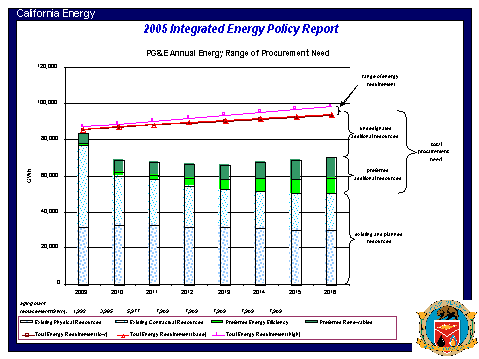
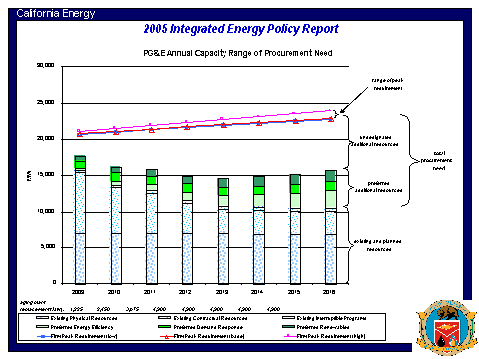
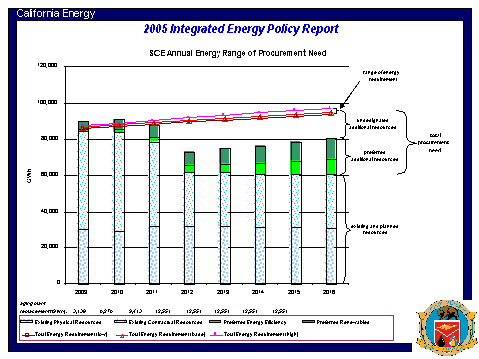
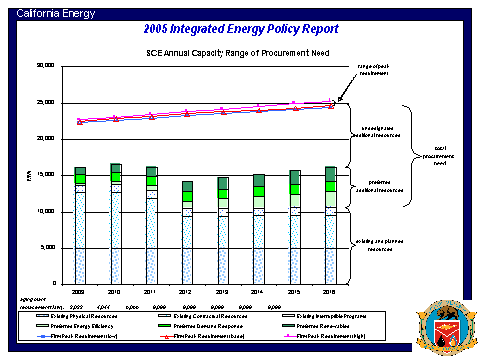
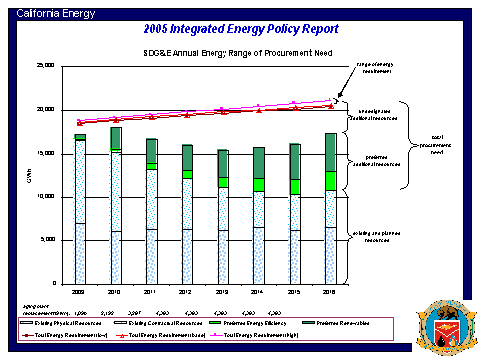
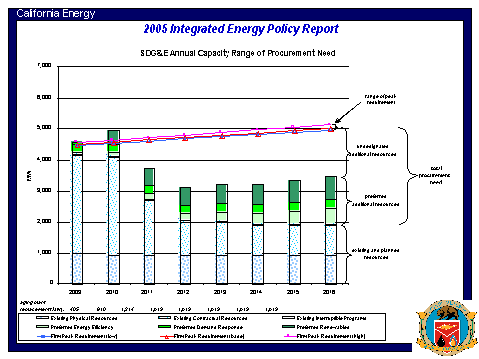
(END OF APPENDIX A)
APPENDIX B
Excerpt from Presentation by Dave Ashuckian, California Energy Commission, Electricity Demand Office, March 14, 2006.
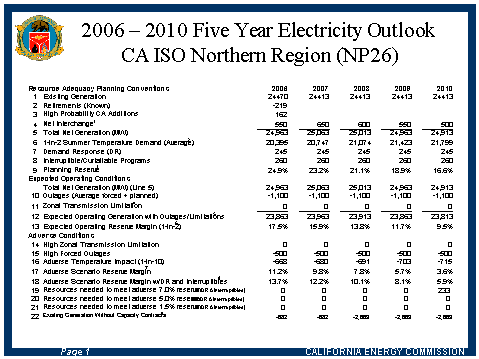
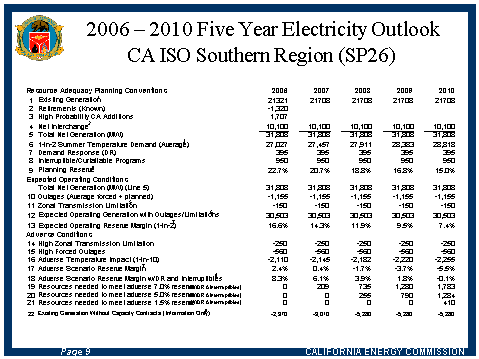

(END OF APPENDIX B)
APPENDIX C
Post-Workshop Comments
I. Comments Encouraging New Generation
A. Joint Parties
The Joint Parties argue that the Commission cannot simply "stay the course" of current regulatory policies and hope that new generation will develop. They explain that current policies have not induced sufficient investment and argue that the Commission cannot ensure the construction of new generation while relying on current policies that would unlawfully burden bundled-service customers with the cost of new generation.
Most of the opposition to the JP focuses on the cost allocation mechanism. The Joint Parties try to refute this opposition by reiterating that the JP is an interim concept only intended to be in place until there is a long-term solution, such as a functioning, centralized capacity market, and the JP is not a new paradigm for procurement that moves in the direction of more utility integration.
The Joint Parties stress that the cost allocation plan set forth in the JP fairly socializes the costs and benefits of new generation to all customers. The Joint Parties stress how unfair it would be to have their bundled-customers solely responsible for the long-term commitments necessary to encourage new generation that will benefit all customers and all LSEs within the IOU's service territory. In addition, the Joint Parties address other questions raised in the comments with the following clarifications: Debt equivalence will not be included in the socialized costs; the JP will not adversely affect the State's adopted loading order from EAP II since conventional resources are only added after preferred resources have been maximized; and the Joint Parties understand the need for transparency and will work with other parties on developing appropriate safeguards, but do not want to delay implementation of the process by attempting to resolve those issues now.
The Joint Parties had the opportunity to have their JP fully vetted at the workshop so they were able to support their proposal by addressing in their comments and reply the issues raised at the workshop. In particular, in response to concerns that the JP39 was moving in the direction of vertical integration of the IOUs, the Joint Parties explain how third-party investment companies can participate in future solicitations for new generation resources. The Joint Parties suggest that once the cost allocation principles in the JP are adopted, certain aspects of the Indicated Parties' plan can be folded into the JP structure, and details can be worked out in future solicitations. While the Joint Parties believe the Indicated Parties' plan is based on some faulty assumptions about the JP, the Joint Parties do not want the discussion of the Indicated Parties plan to delay implementation of the JP as they believe it is necessary to implement it now for system reliability.
B. Joint Parties' Separate Comments
In addition to joining in the JP, SCE, PG&E and TURN each filed an individual set of comments. SCE believes the JP will protect its bundled customers and states that SCE "will not enter into such contracts if its bundled-service customers alone are required to pay the full costs of new generation resources that will support system reliability for all customers."40 SCE also declares that it believes in the efficacy of a capacity market and that the JP should not hinder that market's development. Once a capacity market is functioning, the resources developed by the JP should be submitted to the capacity market.
SCE believes there is no merit to SDG&E's concerns that SCE is attempting to foist costs for new generation on to SDG&E customers by citing the needs as South of Path 15 (SP-15) area needs (instead of just SCE territory).
PG&E joins in SCE's interest of protecting bundled customers and states: "It would be inequitable to require only bundled customers to pay the higher cost associated with such new resources and allow direct access customers to reap the benefits of lower cost existing resources."41 From PG&E's perspective, Commission approval of the new cost allocation methodology is a condition precedent to PG&E finalizing the generation contracts from its recent long-term RFO and for the Contra Costa 8 (CC8) facility so that PG&E can "ensure that its bundled customers are not saddled with a disproportionate share of developing new resources for the region."42 PG&E restates that the JP should apply to utility-owned assets as well as PPAs.
TURN addressed the issue of how much new capacity might be necessary to assure reliable service, while balancing system cost and reliability. TURN argues that the Commission should find that there is a need to be met only if it finds that the resources available to serve its jurisdictional customers will fall short of the 15% to 17% Planning Reserve Margin (PRM) adopted in D.04-01-050. TURN is concerned that if a higher standard of need is adopted by the Commission, there will be additional costs on customers for a limited increase in reliability. In fact, from TURN's analysis of the data, PG&E does not have a need for additional resources through 2011 beyond what it has already committed to (including commitments from its recent RFO) but SCE does have a need before 2012.
If SDG&E is able to go forward with the Otay Mesa PPA with Calpine Corporation, as authorized in D.04-06-011 and on rehearing D.06-02-031, TURN does not anticipate SDG&E having any additional short-term need. Although SDG&E did not join in the JP, TURN suggests that the Otay Mesa Generating Plant (if it is built and comes on line), should also be subject to the JP. TURN also notes that SDG&E's example of having built some new generation shows the need for the JP because SDG&E was able to get Reliability Must Run (RMR) treatment for some portion of the new plants. RMR treatment spreads some of the fixed costs of the plant to all benefiting customers in the local reliability area. TURN notes that RMR treatment is simply not an adequate substitute for the JP since not all areas that need resources can qualify for RMR.
In its reply comments, TURN responds to the JP's opponents by reminding them that it is not in any LSE's or its customers' interest to take on the cost of new generation. Without the incentive that the JP offers for cost allocation, TURN is convinced that no new generation will be built. As TURN puts it, absent a multi-year RAR requirement, "there is an inherent hole in the Commission's RA[R] policy."43 TURN argues that telling IOUS to "just do it" and attempting to force IOUs to sign long-term contracts is unfair to bundled customers. The IOUs, TURN argues, are under no obligation to procure any particular percentage of their bundled customer needs from new capacity. Therefore, the Commission needs to figure out how to ensure new generation needed for system reliability gets built when it is not in the interest of any LSE or its customers to take on such an obligation. TURN states, "It is a major leap of faith for any party to assume that the current schedules in this case, and in R.05-12-013 will necessarily result in the timely development of new generation."44
C. AES
AES was an original member of the Joint Parties, and although no longer a sponsor of the JP, AES continues to support it. From AES' perspective, RAR and LTPP alone will not motivate investors to develop and construct the next wave of incremental generation in a timely fashion. AES, like other independent power producers (IPPs), will not make the capital investment without a stable revenue mechanism.
AES, however, does have a few concerns with the process set forth in the JP. Specifically, AES, questions whether the IOUs will design an RFO that does not favor the utility or its affiliate, especially vis-à-vis issues such as debt equivalence applicability to PPAs. AES offers suggestions to make the RFOs more open and competitive, a topic that will be further developed in Phase II of this rulemaking.
D. DRA
DRA is supportive of the Commission taking some steps to encourage new generation, but prefers certain aspects of the Distco model. However, DRA is very insistent that the Commission must do something now on the cost allocation issue since "relying on RAR as the sole regulatory measure for meeting the approaching resource gap for the 2008-2011 time frame might be ultimately be more costly than if the Commission adopted a limited cost allocation methodology now."45 DRA also supports of an interim cost allocation measure as some insurance against a hastly, and perhaps poorly designed, capacity market. However, DRA cautions the Commission to take the EAP II into consideration and only adopt the low end of the need range for this interim proposal.
E. CARE
CARE generally supports the JP, but would appreciate the opportunity to fairly consider other proposals.
F. CSBRT and CSBA
CSBRT and CSBA acknowledge that new generation is needed now in California and support the JP as an interim approach to achieve that goal.
II. Parties Primarily Preferring to Stay the Course, or Offering
Modifications to the JP
A. CAC/EPUC
CAC/EPUC acknowledge that there is a need for new generation in California now, but they do not support the JP because the cost allocation proposal would assess costs to departing load, which they fear could apply to new cogeneration. In summary, CAC/EPUC do not endorse the JP because they are not convinced it is an interim proposal, but one that could morph into a permanent one, and because it fosters traditional, fossil fuel generation, not cogeneration. The major concern of CAC/EPUC is preserving the place for cogeneration qualifying facilities (QF) in the loading order prescribed by EAP II, and not having the IOUs fill all of their need with traditional generation. However, CAC/EPUC ask that if the Commission adopts the JP, or a similar plan, that it apply the plan to new generation from any source, including new cogeneration facilities.
B. Mirant
Mirant believes that the wholesale power market in California does not produce adequate revenues to encourage and support investment in new generation. From Mirant's vantage point, the Commission's focus should be on fixing the wholesale market structure, but recognizes that an interim plan "may be needed while these market reforms are being implemented and given time to work."46 Therefore, Mirant reluctantly offers modifications to the JP to make it more in line with the Distco plan. Mirant believes this is necessary to signal that market stability is forthcoming and that California is a desirable environment for investment, without the need for "interim" solutions. Mirant does not support the JP as presented, because it perpetuates the existing dysfunction in the market. However, if the Commission adopts an interim measure, Mirant offers the following changes to the JP to create clear boundaries: limit the plan to a specific amount of new capacity for a specific time frame, consistent with moving towards the wholesale market; limit the cost allocation to the RAR portion; and have it apply to PPAs (not utility-owned generation).
In the meantime, Mirant advocates that the Commission continue to implement RAR, as well as reforms to the market redesign technology update (MRTU), and develop and implement a well-designed capacity market. "If a market structure is developed with the right components and allowed time to gain a foothold, it reasonably can be expected to encourage new investment on its own without the need for regulatory constructs being proposed."47
C. Constellation
Constellation's favored position is that the Commission "stay the course" and allow the RAR to work. However, Constellation understands that the "reality of the California energy market is that it is not just the ESPs who are not investing in energy infrastructure in California--no one is investing, not ESPs, not generation developers, not the investment banks, not the IOUs, not customers--because market signals in California do not show a need for new capacity."48 From Constellation's perspective, it would be imprudent today to buy new generation unless investors can get a guarantee to charge "more that the current prevailing market price." Therefore, Constellation fears that investment backed by regulatory guarantees will remain the primary source of infrastructure investment in California, until and unless there is a competitive market.
Constellation urges the Commission to either reject the JP, or if it adopts the JP, to modify it so the Commission is taking steps consistent with where it ultimately wants to go. "To the extent the Commission determines that resources must be committed now to ensure reliable grid operations, there is a need for interim investment policies. The critical task, ..., is to ensure that the "fix" does not become an impediment to the success of the emerging wholesale market structure."49 Constellation would prefer that the Commission explore the Distco plan as an alternative to the JP, but in any event, advocates that the Commission should provide clear direction that any interim proposal will be replaced with a competitive market investment incentives supported by RAR and CAISO's MRTU.
D. Aglet
Aglet opposes the JP and the Distco plan from a concern that the IOU customers would not receive 100 % of the benefits from the new generation, but might get 100% of the costs. Aglet is concerned that there could be legal and administrative impediments to spreading the costs of new generation, and therefore the bundled IOU customers would be burdened with the cost. Aglet wants the IOUs to procure just for their bundled customers. As Aglet comments, "the Commission must determine whether the need for new generation is severe enough to eliminate a workable system and replace it with an experimental cost allocation method."50 Aglet points to PG&E's recent RFO for the proposition that mechanisms already exist to ensure that there are long-term contracts available. From its perspective, Aglet recommends that the Commission order each IOU to fill its required need, and new generation should be added only if it is cost effective.
E. AReM
AReM's comments focus mainly on opposing the JP. Instead of adopting a new program, AReM urges the Commission to direct the IOUs to procure for the needs of their bundled customers, just like SDG&E did two years ago when it held an RFO for grid reliability. AReM thinks the Commission should consider sanctions against PG&E and SCE for willfully avoiding filling their obligations to procure for their bundled customers.
AReM is concerned that the JP just adds to the regulatory uncertainty that investors find as an impediment to investment in California. AReM also questions whether the cost allocation mechanism in the JP is legally sustainable. If not, there would be further market distortions. Therefore, AReM advocates the policy of "staying the course" and allowing current policies to work. If the Commission is inclined to adopt a new policy, AReM recommends the following: clearly define the need for new capacity; decouple energy and capacity and have the IOUs procure energy only for their bundled customers, do not allow the JP for utility-owned generation, and limit the interim plan to five years.
F. POU Parties
Merced Irrigation District, Modesto Irrigation District, South San Joaquin Irrigation District, Northern California Power Agency and the California Municipal Utilities Association, herein referred to as the Joint POU Parties, oppose the JP. However, they are not against the concept that the Commission should adopt some other new measure to encourage new generation. A major concern of the Joint POUs is that costs may be shifted for generation that is consumed by IOU bundled customers to customers of Joint POU parties from the IOUs. In addition, the Joint POUs urge the Commission not to adopt a hastily drafted plan that was subject to workshops, but ask that any proposal be deferred to a proceeding where it can be more fully explored.
If, however, the Commission is considering the JP, the POU parties request the following modifications: clarify that POU parties outside of the CAISO control area will not be subject to the JP; require the IOUs to forecast customer movements from IOUs to POUs so that the IOU does not procure for those departing customers; clarify that "IOU nondistribution transmission customers" are not included; eliminate all suggestions that POU customers should have responsibility for future LTPP decisions of IOUs; and clarify that Assembly Bill (AB) 380 does not include POUs within the definition of an LSE.
G. Sempra Global
Sempra states that "[t]he Commission cannot create a stable regulatory environment, promote new investment in infrastructure, or even expect that its policies will be taken seriously if it continually suspends, overrides and tinkers with its programs before it has gone through even a single cycle of procurement."51 From Sempra's vantage point, if guidance is needed from the Commission, it is on how rules and policies will be enforced--not on how the rules and policies should be changed. In particular, Sempra blames PG&E and SCE for creating the alleged problem by refusing to procure the resources ordered in the last LTPP decision, D.04-12-048. In fact, only SDG&E carried through and met the needs of its service territory and sought to have the incremental benefits shared through RMR contract designation.
While urging the Commission to "stay the course," which to Sempra means implementing RAR rules and a capacity market, Sempra also alternatively provided input on modifications to the JP. Sempra's primary goal is to limit the impacts of any new proposal on the development of wholesale and retail markets. Therefore, Sempra recommends the following modifications to the JP: limit any interim mechanism to a one-time RFO; limit it to "urgent need"; do not retroactively apply the interim mechanism to PG&E; limit the cost allocation methodology to three to four years, subject to a revisit; allow LSEs to "opt out" if they can demonstrate they have sufficient resources; allow LSEs that procure new long-term resources to transfer fixed cost to the local IOU for recovery through the distribution-rate surcharges; do not permit cost allocation to apply to utility-owned generation or affiliate transactions; permit affiliate transactions and utility-owned generation so long as costs are recovered from bundled customers only; require the utilities to make public the winning contracts subject to cost allocation; make IOUs subject to reasonableness reviews for their procurement and dispatch of these resources; and design an interim plan which terminates once a centralized capacity market is functioning.
Sempra prefers the modifications it suggests to the Distco model as Sempra fears that despite its intentions, the Distco plan could be anticompetitive in the long term. Instead, the units subject to the cost allocation mechanism should be required to offer an energy option based on a heat-rate strike price to all customers paying the distribution charge. In its reply, Sempra counters arguments claiming that only the IOUs are willing or capable of making long-term resource commitments. Sempra submits that its nonutility LSE would be willing to undertake additional procurements if the Commission further requires that LSEs should procure a certain percentage of "new" resources as part of their RA obligation.
H. CLECA/CMTA
CLECA/CMTA urge the Commission to "stay the course." They do not find the JP interim, necessary or equitable and argue that adoption of the JP will "fundamentally alter the market structure in California, further eroding investor confidence in California's regulatory stability."52 In addition, CLECA/CMTA see the IOUs, in particular PG&E and SCE, as playing a game of "chicken," with their refusal to follow through with their approved LTPPs from D.04-12-048. CLECA/CMTA find no regulatory impediment to the IOUs signing long-term contracts, and claim that both IOUs are failing in their responsibilities as public utilities.
If however, the Commission does consider the JP, CLECA/CMTA urge that it be modified as follows. The JP should not (1) be applied retroactively to PG&E's recent long-term RFO and to Contra Costa 8; (2) be applied to utility owned generation; and (3) last longer than 10 years. Also, CLECA/CMTA argue that an IOU is not the only entity that can procure new generation. CLECA/CMTA are also concerned that if the JP is adopted, non-bundled customers will pay for above market costs of energy procured to serve bundled customers without having access to the energy. Finally, CLECA/CMTA posit that the JP does not address whether IOUs will seek to procure new generation in locations that solve local RA problems.
CLECA/CMTA also raise the issue of whether the JP would only be a transitional mechanism. CLECA/CMTA are concerned that it will become permanent, fundamentally altering the market structure of California.
I. Green Power Institute
On fundamental principles of fairness, Green Power opposes the JP as being "considerably more generous" than any cost mechanism available through the RPS program. Previously, TURN suggested using IOUs as a means of facilitating the procurement of renewable power by the smaller LSEs, and Green Power supports that concept if it could be implemented through the JP.
J. IEP
IEP opposes the JP primarily on the ground that "staying the course" will provide the regulatory certainty needed for new generation. IEP does not want the Commission giving the IOUs more control over procurement, because it fears that the JP is moving towards utility integration. However, if the Commission adopts the JP, IEP suggests that the Commission consider that the procurement entity be someone other than an IOU.
From IEP's perspective, the problem lies with the IOUs and the way the IOUs design the RFOs. If the solicitations were all-source, they could result in "the optimum mix of new generation, existing generation and repowering projects if [the solicitations were] given a chance to function as the Commission intended."53 According to IEP, the resource shortage problem is not the result of the current cost-allocation scheme, but a combination of the following: regulatory incentives that favor utility owned generation over PPAs; utilities being primary purchasers and sellers of power; IOUs finding unique-fleeting-opportunities (UFOs) to present to the Commission, rather than holding all-source competitive solicitations; the procurement process is lengthy and draped in excessive confidentiality; IOUs impose high credit requirements in their RFOs; and the debt equivalence adds to the cost of the PPAs.
K. WPTF
WPTF opposes the JP for the following reasons: the JP is not needed for reliability or to ensure RA compliance; it obstructs the long-term solution of all-source solicitations, capacity market and direct access; it creates a new stranded cost; it harms competitive markets by tasking the IOUs with the responsibility of procuring power for their competitors; bundled customers are already protected from stranded costs through the 10-year NBC authorized by D.04-12-048; and it will cause billing and price transparency problems. Instead, WPTF advocates that the Commission "stay the course" and not impose a temporary solution to address a scenario brought on by PG&E and SCE's refusal to procure sufficient resources. In the alternative, WPTF urges the Commission to order the IOUs to procure resources through all-source solicitations.
However, if the Commission chooses to adopt an interim plan, WPTF alternatively offers the following suggestions: require all-source solicitations; limit the number of MWs procured based on CEC and CAISO needs assessments; provide for an opt-out for non-utility LSEs upon a showing of RA; limit any IOU backstop procurement to RAR capacity only; make bids open and transparent; apply the policy only apply to PPAs, not utility owned generation and not to PGE's commitments from its recent RFO; do not extend the policy beyond 10 years; require that the entity procuring new capacity be anyone other than an IOU; and unbundle the energy and capacity components of the contract, as suggested in the Distco plan so as to maximize the energy rent.
L. SDG&E
SDG&E opposes the JP since the utility fears it will result in cross subsidies and potential stranded costs. SDG&E is particulary concerned that SCE might procure new resources, without first determining SDG&E's need for that capacity. SDG&E does not want SCE allocating 20% of the SP-15 shortfall to SDG&E regardless of SDG&E's resource position. Instead, SDG&E urges the Commission to focus on long-term solutions and move towards a capacity market, and not adopt the JP -- because it is really a long-term mechanism in disguise. If however, the Commission is considering the JP, SDG&E advocates having an opt-out provision for LSEs that are fully resourced.
M. SVLG
SVLG opposes the JP mainly on the ground that it represents a policy change toward returning IOUs to favored market position. SVLG does not believe that financing new power plants in California is difficult because of shifting customer bases, but rather because of the uncertainty of market rules. Instead, SVLG strongly supports "staying the course." However, if the Commission is considering an interim proposal, SVLG prefers aspects of the Distco plan to the JP, but only while the Commission is continuing to develop the LTPP and RAR framework. If SVLG urges that any interim proposal should only apply to peaking plants to secure reliability, that IOUs should procure base load or intermediate plants for their own growing energy needs, and that in no event, should the JP apply to utility ownership.
III. Parties Supporting Distco Plan or Who
Take No Position on the JP
A. CEC
The CEC is the drafter of the 2005 IEPR and as such, the CEC's role in this phase of the proceeding is to coordinate the transmittal of the information developed and analyzed in the preparation of the IEPR for use in the Commission's 2006 LTPP proceeding. Consistent with that role, the CEC did not take a position on the JP. Instead, the CEC advocates "staying the course" and does not see that there are any barriers to the IOUs obtaining long-term contracts, except for a need for "coming and going" rules to deal with the uncertainty of future departing and returning load. According to the CEC, if the Commission adopts "coming and going" rules by the end of 2006 as the CEC recommended in its 2005 IEPR, that should provide an alternative to the cost-sharing mechanisms in the JP and the other proposals.
The CEC established the range of need for the three IOUs in the IEPR and believes that its "contractually based range of need" numbers demonstrate that IOUs have sufficient need for new resources to (1) serve the demand for their bundled customers and (2) reduce dependence on old and inefficient power plants. The CEC is concerned that if the Commission wants to determine a separate "physical need" number for this proceeding, this process is likely to be contentious and require a significant expenditure of time and resources to resolve and will delay the issuance of this decision.
B. Indicated Parties
As discussed earlier in this decision, the Indicated Parties made modifications to the Investco proposal discussed at the workshop, produced their own proposal dubbed Distco, and urge the Commission to adopt the Distco model in lieu of the JP. In their reply comments, the Indicated Parties favor further consideration of proposals that will (1) unbundle the capacity and energy components of any new generation procured; (2) limit the need for cost allocation to the RA component; and (3) allow energy rights of new resources to be acquired and paid for by individual market participants through a forward auction. In addition, the Indicated Parties believe that their proposal can be implemented quickly.
C. FPL Energy, LLC
FPL Energy, LLC only filed reply comments that indicated support for the Indicated Parties' proposal.
IV. Other Comments
A. CAISO
CAISO does not comment on the JP or the Distco plan, but instead limits its response to the "needs" issue. In terms of need, CAISO reiterated the "Three R's" of RAR: (1) the right mix of resources; (2) resources that are in the right location; and (3) the right amount of resources. In summary, out of its concern for sufficient resources, CAISO recommends that the Commission periodically conduct cost/reliability analysis projected over the expected term of the LTPPs to reaffirm or adjust the level of resource insurance that is in the best interest of California consumers as the state's resource supply and demand projections evolve over time.
B. RCM Biothane
RCM's concern is that the JP must be adjusted to exempt net-metering customers from any non-bypassable charge.
C. Good Company Associates on Behalf of TAS
Good Company presents a proposal of its own: the Commission should utilize technology it has available, Turbine Inlet Cooling, to provide additional capacity in a more expeditious manner. Good Company's proposal is based on the premise that in the long run, market forces are generally superior to regulation. However, to resolve short-run reliability problems, TAS has technology available that may help provide a bridge until long-run solutions work.
D. Davis Hydro
Davis Hydro urges the Commission to utilize available small distributed renewable generation to increase RA.
E. CCDG
CCDG Coalition recommends that the integrated planning process should include the establishment of procurement targets for distributed generation (DG). In light of the IEPR and EAP II, the Commission should consider requiring the LSEs to have annual procurement targets for combined heat and power facilities.
F. WEM
WEM advocates that the Commission follow the EAP II priority and focus more on energy efficiency (EE) rather than building more fossil-fueled generation. WEM fears that the JP will block development of cleaner resources for the 30-year life of the new plants and condemn the state to uncontrolled global warming. Instead, WEM argues that the Commission could address the generation shortage issue by the following: acting though EE matters; making EE a local resource; and making EE show up in supply forecast.
(END OF APPENDIX C)
INFORMATION REGARDING SERVICE
I have provided notification of filing to the electronic mail addresses on the attached service list.
Upon confirmation of this document's acceptance for filing, I will cause a copy of the Notice of Availability to be served upon the service list to this proceeding by U.S. mail. The service list I will use to serve the Notice of Availability of the filed document is current as of today's date.
Dated June 20, 2006, San Francisco, California.
/s/ FANNIE SID |
Fannie Sid |
************ APPEARANCES ************ |
John R. Redding |
Michael E. Boyd |
R. Thomas Beach |
Gregory Klatt, Attorney At Law |
Steve Isser |
Gregg Morris |
Audrey Chang |
Lisa Urick |
Michel Peter Florio |
********** STATE EMPLOYEE *********** |
David Vidaver |
Andrew Campbell |
Karen M. Shea |
Vitaly Lee |
Stacy Aguayo |
Scott Blaising |
Steven S. Schleimer |
Lisa Decker |
Gregory T. Blue |
Adrian Pye |
Mark J. Smith |
David Olsen |
Richard W. Raushenbush |
C. Susie Berlin |
|
Tim Hemig |
Grace Livingston-Nunley |
Rick C. Noger |
Kurt Kammerer, Director Of Programs |
Justin D. Bradley |
Roger Pelote |
39 In post-workshop comments, the JP included SCE, PG&E, NRG, TURN, CURE, and CURE. Another party on the original proposal, AES, filed separate supportive comments.
40 SCE Comments, p. 3.
41 PG&E Comments, pp. 5-6.
42 PG&E Comments, p. 6.
43 TURN, Reply Comments, p. 4.
44 TURN, Reply Comments, p. 7.
45 DRA Comments, p. 7.
46 Mirant Comments, p. 5.
47 Mirant Comments, p. 10.
48 Id., p. 13.
49 Constellation Comments, p. 15.
50 Aglet Comments, p. 4.
51 Sempra Comments, p. 2.
52 CLECA/CMTA Comments, p. 3.
53 IEP Comments, p. 2.


